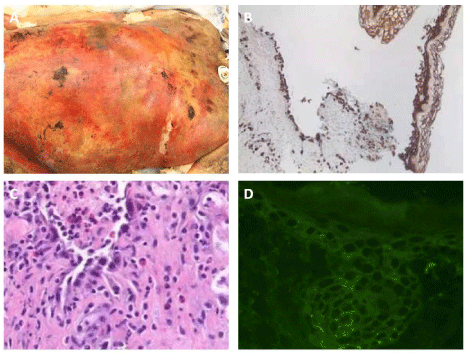
Clinical Image
Austin J Clin Pathol. 2016; 3(1): 1039.
Paraneoplastic Pemphigus in Setting of Waldenstrom’s Macroglobulinemia
Oregel KZ*, Ratanatharathorn C and Nagaraj G
Department of Hematology and Medical Oncology, Loma Linda University, US
*Corresponding author: author: Karlos Z. Oregel, Department of Hematology and Medical Oncology, Loma Linda University, Shuman Pavilion 11175 Campus Street, Loma Linda, California 92350, US
Received: February 02, 2016; Accepted: February 11, 2016; Published: February 11, 2016;
Clinical Image
61-year-old male with history of treated Waldenstrom’s macroglobulinemia presented with fever, sore throat and rash. Rash was characterized as pruritic, with confluent erythematous plaques and superficial pustules. Initially appeared on lower extremities and progressed to involve the entire body (Figure 1). Skin biopsy revealed a separated epidermis (subepidermal and suprabasilar clefting) with necrotic keratinocytes and eosinophils in the epidermis (Figure 1). Elevated serum antibody titers against Desmoglein 1 and 3, monkeyesophagus and rat bladder were noted. Direct immunofluorescence demonstrated intercellular staining for IgG with weak basement membrane staining for C3 suggesting a diagnosis of paraneoplastic pemphigus (Figure 1). Patient was then started on solumedrol, IVIG and rituximab with no improvement.

Figure 1: 1: Panel A shows autopsy corpse with diffuse systemic
dermatological findings consistent with paraneoplastic pemphigus secondary
to Waldenstrom’s Macroglobulinemia. Panel B and C shows scattered
keratinocytic necrosis within the separated epidermis and a mixture of both
subepidermal and suprabasilar clefting. Panel D showed the presence of
serum cell surface IgG antibodies detected by cutaneous immunofluorescence
testing on monkey esophagus substrate.
Patient subsequently developed multi organ failure requiring intubation, vasopressors, inotropic support, and hemodialysis before expiring. An autopsy showed atypical lymphoid infiltrate of the pancreas, liver, adrenal glands and lymph nodes consistent with involvement of Waldenstrom’s macroglobulinemia.